| 1 | Super widespread in South America |
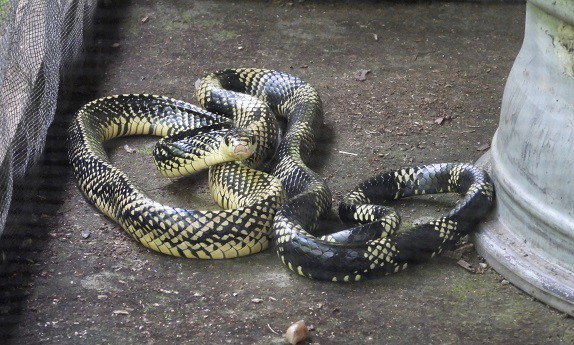
If there’s a global award for snakes that are large, extremely widespread, yet barely heard of among Westerners, then it’s probably held by the tiger ratsnake, AKA Spilotes pullatus. This is a non-venomous species which is secretly one of South America’s largest snakes, occasionally reaching 3 metres, with males slightly larger than females.
Tiger ratsnakes are vivid black and yellow, and very difficult not to notice when slithering past. They have poor camouflage, but don’t particularly need it, as this is an energetic snake which is more than able to defend itself with vicious, lunging blows, despite its complete lack of venom.
Like the boa constrictor, tiger ratsnakes are found in every single South American country except Chile, which they’re blocked from by the spinelike Andes mountain range. In fact, tiger ratsnakes are even more widespread than the boa constrictor, whose Central American territories were recently separated into a new species: Boa imperator.
Tiger ratsnakes can be found all the way from eastern Mexico to northern Argentina. They inhabit all 7 central American countries, and every corner of Brazil, from rainforest to cerrado to Pantanal wetlands. Tiger ratsnakes don’t quite reach southern Texas, falling short by a few hundred miles.
| 2 | Inflates its throat grotesquely |
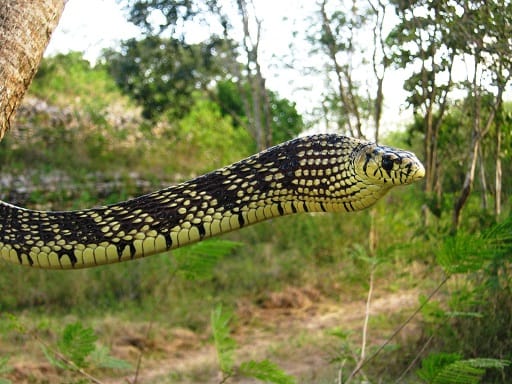
Tiger ratsnakes mainly coexist peacefully with humans. They live in forests, forest edges and villages, coping well with manmade habitats. They lack venom, but possess a vast range of other weapons they can deploy at will. One is rearing up and inflating their throat, creating such a large bulge that an egg or rodent appears to be lodged inside. This inflation makes the bright yellow of their throat more visible, and creates a false impression of size, almost doubling their width.
Fleeing is another option, which tiger ratsnakes can easily accomplish using their darting speed. Many will vibrate their tail in leaves, to create a buzzing sound, exploiting their environment rather than relying on an actual rattle. Tiger ratsnakes may coil into an S-coil, to give an impression that they’re about to strike. Sometimes, they mean what they say and will lunge at you viciously. If all else fails, they’ll bite, which isn’t especially painful (unlike with the small-banded kukri snake), but enough to give you nightmares for several days.
Tiger ratsnakes hiss relatively rarely. In fact, they were only proven to do so in a recent study from 2020. This snake hung its mouth half-open, and charged several times at the researchers. Tiger ratsnakes are no cowards, and will rarely shrink into a pile of leaves and cover their head. However, a separate 2020 study found that tiger ratsnakes had a highly variable personality. Some encountered in the Sete Barras region of south-eastern Brazil were aggressive, while others were surprisingly docile.
| 3 | Climbs trees effortlessly |
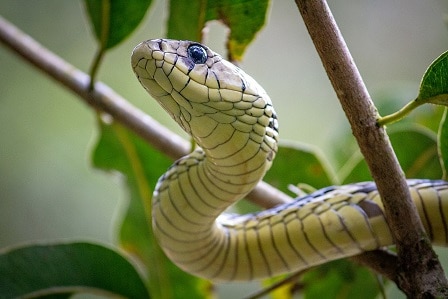
Tiger ratsnakes are excellent tree climbers, and are often spotted curled around a branch. They’re not fully tree-dwelling, unlike an annulated cat-eyed snake, and their body is too thick to effortlessly leap between the thinnest branches. But when they approach a tree trunk, they slither upwards as effortlessly as a human climbing a stairwell.
This factors into a relatively unusual diet, as Spilotes pullatus is one of the heaviest bat-eating snakes. Species confirmed include black mastiff bats and Jamaican fruit bats, the latter also being eaten by Cuban boas.
The first observation happened accidentally. Scientists were observing a roost of black mastiff bats in the Poço das Antas Biological Reserve, Rio de Janeiro state. The bats were sheltering in a roof, but the team then noticed a 2.15 meter tiger ratsnake, resting on a branch nearby, with a large bulge in its belly. It was just 2 metres from the bat colony. The feeding wasn’t observed, but the clues were hard to ignore. This took place in January 2001, and in April 2001, another tiger ratsnake was spotted lurking by the same roof, possibly attracted by an accumulation of bat scents over time.
| 4 | Pinches birds directly from nests |
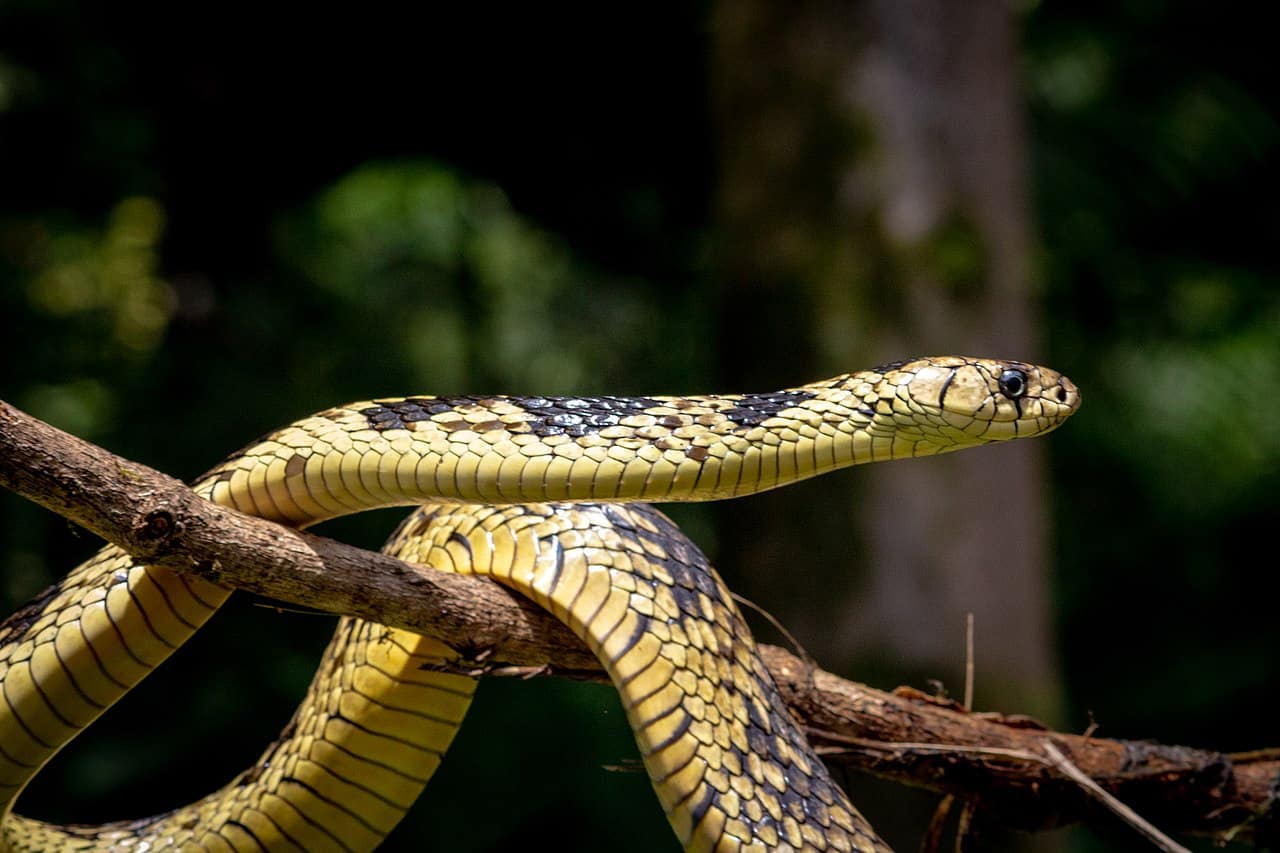
In 1979, scientists found a Jamaican fruit bat roost 13 metres up a fig tree in Panama. In July, they witnessed a tiger ratsnake slither out of this roost with 5 large bulges in its belly. Supposedly, the adjacent tree had only just grown high enough for snakes to assault the roost. This observation also showed the great heights that tiger ratsnakes can reach. 10 metres above ground has been recorded repeatedly, and this snake refused to come down lower than 12 metres.
Tiger ratsnakes also pinch birds directly out of their nests. Trogons and thrushes are confirmed bird prey. Sometimes things go wrong. In December 2012, scientists in Ceará, Brazil observed a tiger ratsnake trying to prey on the eggs of a rufous-bellied thrush, stealing its eggs directly from the nest. The attempt failed, as the thrushes ganged up and mobbed the snake, forcing it to retreat.
A fluffier creature they eat is Deppe’s squirrel, a species found in Chiapas state, Mexico. The tiger ratsnake killed the squirrel within 2 minutes. For some reason, it then seized the body by the hind leg and dragged it 3 metres further up the tree before commencing swallowing.
| 5 | Ever-changing colour ratios |
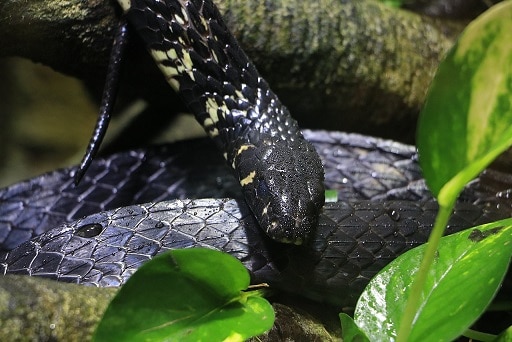
Like most diurnal (day-faring) snakes, tiger ratsnakes have round pupils rather than vertical. Their tongue is fully black, while their head is moderately distinct from their body, but not a sudden bulky triangle like the average viper.
Tiger ratsnakes are one of South America’s easiest snakes to recognise. Their colours are not only vivid, but no other snakes measuring 3 metres have those colours (a couple of tinier ones do). The colours themselves are mostly consistent. It’s always a pitch black, contrasting against paler sections, which are usually yellow, but sometimes a paler cream, or occasionally a darker orange. This varies geographically, but also within locations – the exact subspecies of Spilotes pullatus are still a mystery. The main variation in tiger ratsnakes are the precise portions of black and yellow. In some, the forces of darkness push back the paleness, while in others, the banana yellow dominates all. In a few, one colour nearly destroys the other completely. See above for a much blacker tiger ratsnake than average.
Tiger ratsnakes have many names. A Mexican version is Volador, which is Spanish for flying, referencing how they zip through vegetation a couple of metres high. Another name is “thunder and lightning snake”, referencing the sharp contrast between electric yellow and midnight black.
| 6 | Ritualistic male combat |
Male wrestling isn’t especially rare in the snake kingdom, but nor is it common. Among 3900 species, the noble art of male duelling is confirmed in a few dozen species, including the small-banded kukri snake. Tiger ratsnakes have multiple confirmed records of wrestling, and a 2013 study detailed four alone. Two happened on Cardoso Island, São Paulo state, one in Mato Grosso do Sul state and another in Goias state (all in Brazil). In all four duels, the two male snakes never bit each other. They intertwined their lower bodies, then attempted to raise their head above the rival. Then they would smash the rival’s head to the floor. The victim would stay alert and rapidly swish its head free, trying to get the upper hand again. This head-raising game is common, and has been confirmed in several species…
- Small-banded kukri snake.
- Machete savane.
- California kingsnake.
- Hemprich’s coral snake
On average, the wrestling bouts in tiger ratsnakes lasted for one hour. In battle 4, the smaller snake actually won, sending the larger snake scampering into the undergrowth. As a rule, larger snakes tend to win wrestling matches, but this smaller snake may have had more energy as a result of feeding recently, or perhaps it had an inherently more aggressive personality. This ties in with the extreme variations in personality for tiger ratsnakes mentioned earlier.
In two out of four duels, three tiger ratsnakes were present, hinting that one was a female, and that her mere presence was enough to send the males into an all out competitive brawl. But in two battles, the season was late spring, outside of their breeding season of early spring. It’s possible that tiger ratsnakes wrestle for reasons other than female affections, possibly for territory, to scare away rival males in order to preserve their local food resources.
| 7 | Copes well with manmade habitats |
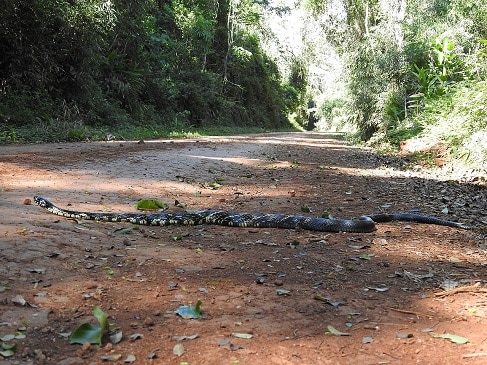
In 2014, a study ventured to the Atlantic forest of southeast Brazil, and analysed the tiger ratsnake’s ecology in detail for the first time. The largest male measured 254.0cm, and the largest female 229.5cm. When testing habitat, the team made 178 observations of tiger ratsnakes. They turned out to be a lowland species, appearing from 0-930 metres above sea level, but 79% of observations were below 200 metres.
Confirming the old suspicions, it turned out that tiger ratsnakes coped well with manmade influence. They appeared in degraded areas barely any less frequently than pristine, preserved forests. Meanwhile, the local sipos (Chironius family) were rarely found in degraded spots. The study proved the diurnal, not nocturnal nature of tiger ratsnakes. All snakes were observed from 7:00 to 17:00. The snakes were most commonly spotted on the ground, but also resting on vegetation and branches.
Diet was tested too. 42 prey records from 37 tiger snakes were gathered. The result was a diet of 88.1% mammals (37), and 11.9% birds (5). There were no lizards, amphibians or fellow snakes recorded. 7 of the 42 prey were bats or nestling birds, which tiger ratsnakes would have to climb to obtain.
| 8 | Prefers smaller prey |
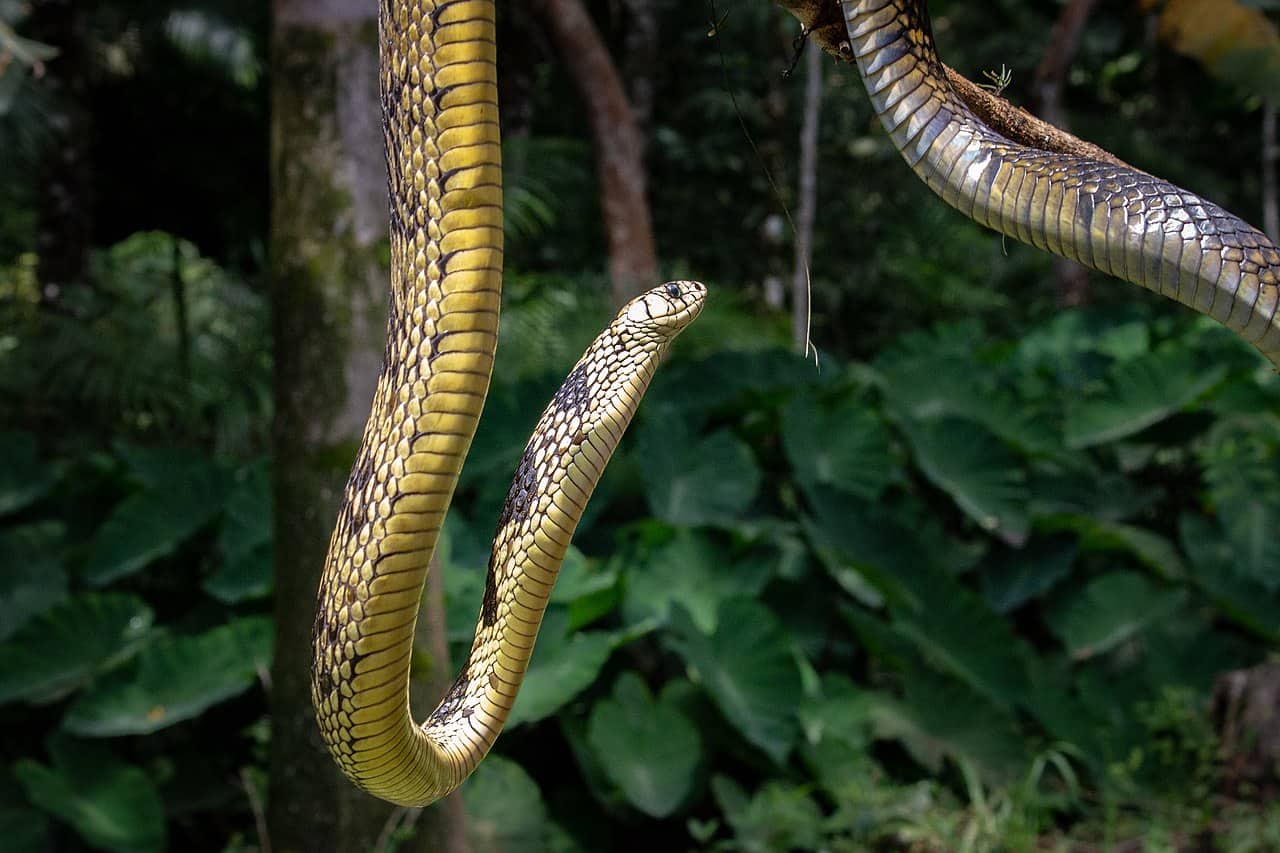
It turned out that like the black mamba of Africa, tiger ratsnakes preferred relatively small foods. Their prey in the wild ranged from 0.36–7.37% of their own body weight.
The study also included a laboratory portion, where tiger ratsnakes were thrown various prey items and observed. For small rodents, they were extremely fast eaters, gulping down one prey in just 4.2 seconds. For small prey, the range 4.2-300 seconds. They achieved this through typical snake means, using alternating movements of the left and right mandibles until the jaw had fully devoured them. Larger rodents were trickier, with the chunkiest taking 32 minutes and 16 seconds to swallow.
Tiger ratsnakes turned out to be a reckless eater as well as fast. 30% of snakes that ate larger rodents regurgitated them, and 3 died, all of which had swallowed rodents 30% of their own body mass or more. An African rock python can easily swallow a small gazelle over 100% of its body weight. Somehow, tiger ratsnakes are more limited. Speed is their forte, but not a stretchy belly. Overall, it was tricky for tiger ratsnakes to ingest prey over 15% of their body weight.
| 9 | Savage, jabbing lunges |
At first, tiger ratsnakes seem ill-equipped to hunt. They lack venom, and while they make a few loose coils, they lack true constricting powers. The odds are against them. But tiger ratsnakes have speed, and most importantly, they have one of the most manically fast strikes in South America. Check out this short video for proof. A tiger ratsnake can switch from dozing merrily, to a blistering, jabbing assault that brings you face to face with the full power of an enraged serpent.
In the wild, tiger ratsnakes simply chase their prey and grabble with their coils, not really constricting, but holding them down. They commonly press their prey hard against an object, like a wall in a terrarium.
According to this keeper, they even kill their prey via suffocation. Tiger ratsnakes will open their mouth and force a rodent’s head into the upper section of their throat. Then they’ll stay eerily still for 30 seconds, before the rodent dies of oxygen starvation. Another characteristic of tiger ratsnakes is that they’re especially reliant on visuals, with tongue flecking for scents as a trusty backup.
| 10 | Constantly weaving between predators |
Tiger ratsnakes also face obstacles in the wild, namely a colourful cast of predators. The solitary eagle (Harpyhaliaetus solitarius) has been photographed with a tiger ratsnake in its talons, while resting on a tree branch. It’s almost confirmed that grey foxes hunt them. In Mexico’s Yucatan peninsula, this fox was seen carrying a tiger ratsnake in its jaws, in Komchén de los Pájaros, a private reserve of tropical deciduous forest. 8 camera traps were set by researchers, operational 24 hours a day, and the tiger ratsnake’s demise was captured on camera 4.
Snake predators are also confirmed, although most aren’t large enough to suck them down. In 2011, scientists recorded a Middle American indigo snake swallowing a tiger ratsnake in a forest reserve in Tamaulipas, México. For an hour, it tried to swallow its meal, and retreated under a rock. When the scientists returned, the tiger ratsnake was lying there, regurgitated, and the indigo snake was gone. This species is a southerly cousin of Florida’s eastern indigo snake.
The keeper above also confirmed how easy it is to overfeed tiger ratsnakes. An associate of his had dropped 16 mice into a cage containing 4 tiger ratsnakes. One greedy individual swallowed 6 or 7, and that snake was later found dead. Tiger ratsnakes are like a mindless vacuum cleaner. They appear to have no restraint when it comes to food.
